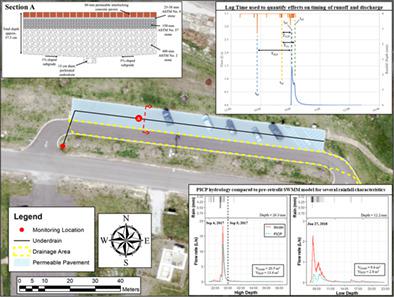当前位置:
X-MOL 学术
›
Hydrol. Process.
›
论文详情
Our official English website, www.x-mol.net, welcomes your
feedback! (Note: you will need to create a separate account there.)
Impacts of permeable interlocking concrete pavement on the runoff hydrograph: Volume reduction, peak flow mitigation, and extension of lag times
Hydrological Processes ( IF 2.8 ) Pub Date : 2021-04-10 , DOI: 10.1002/hyp.14167 R. Andrew Tirpak 1 , Ryan J. Winston 1, 2 , Melissa Feliciano 3 , Jay D. Dorsey 1 , Thomas H. Epps 4
Hydrological Processes ( IF 2.8 ) Pub Date : 2021-04-10 , DOI: 10.1002/hyp.14167 R. Andrew Tirpak 1 , Ryan J. Winston 1, 2 , Melissa Feliciano 3 , Jay D. Dorsey 1 , Thomas H. Epps 4
Affiliation

|
Permeable pavements are implemented to provide at‐source treatment of urban stormwater runoff while supporting vehicular and pedestrian use. Studies on these systems have mainly focused on those treating only direct rainfall and installed atop well‐drained soils which typically provide substantial hydrologic mitigation through exfiltration that may not be representative of more hydrologically taxing conditions. A single lane parking area retrofitted with permeable interlocking concrete pavement in Vermilion, OH, USA was monitored over a 15‐month period to quantify its hydrologic performance under such conditions. The 470 m2 permeable pavement was underlain by silt loam soils and a shallow bedrock layer and treated run‐on from the adjacent 324 m2 asphalt drive lane. Observed data were compared to a calibrated SWMM model developed to simulate the pre‐retrofit conditions of the site (i.e., a completely impervious parking lot). Cumulative runoff volumes were reduced by 43% across all events in the monitoring period compared to a fully impervious parking lot. While median peak flows were reduced by 75%, substantial mitigation was limited to smaller, lower intensity events with longer antecedent dry periods (i.e., non‐flood producing events). The permeable pavement significantly delayed the occurrence of peak flows from the site following peak rainfall intensity by a median 29 min. Results from this study demonstrate that permeable pavements which receive run‐on from adjacent imperious cover and are installed atop poorly drained soils can significantly reduce runoff volumes and peak flow rates and delay the occurrence of peak discharge. The modelling approach implemented can provide a better estimation of diffuse inflows to green infrastructure stormwater controls and aid in refining design features which enhance the hydrologic performance in systems underlain by poorly drained soils.
中文翻译:

渗透性互锁混凝土路面对径流水位的影响:减少体积,减少峰值流量和延长滞后时间
实施透水路面可在源头上处理城市雨水径流,同时支持车辆和行人使用。对这些系统的研究主要集中在仅处理直接降雨的系统上,并安装在排水良好的土壤上,这些土壤通常通过渗漏提供实质性的水文缓解作用,可能无法代表更多的水文征税条件。在15个月的时间内,对美国俄亥俄州Vermilion的一个装有渗透性互锁混凝土路面的单车道停车场进行了监测,以量化其在这种条件下的水文性能。470 m 2的渗透性路面由粉质壤土和浅基岩层覆盖,并在相邻的324 m 2处经过处理沥青行车道。将观察到的数据与为模拟场地的改装前条件(即完全不透水的停车场)而开发的经过校准的SWMM模型进行了比较。与完全不透水的停车场相比,在监控期间所有事件的累积径流量减少了43%。虽然峰值中位数流量减少了75%,但实质性的缓解措施仅限于较小,强度较低的事件,且干旱前期较长(例如,非洪水事件)。在峰值降雨强度之后,渗透性路面显着地延迟了该地点峰值流量的发生,平均时间为29分钟。这项研究的结果表明,可渗透的路面可从相邻的不均匀覆盖层上穿行,并安装在排水不良的土壤上,可显着减少径流量和峰值流量,并延迟峰值排放的发生。所采用的建模方法可以更好地估算绿色基础设施雨水控制系统的扩散流入量,并有助于完善设计功能,从而提高排水不良土壤下的系统的水文性能。
更新日期:2021-04-29
中文翻译:

渗透性互锁混凝土路面对径流水位的影响:减少体积,减少峰值流量和延长滞后时间
实施透水路面可在源头上处理城市雨水径流,同时支持车辆和行人使用。对这些系统的研究主要集中在仅处理直接降雨的系统上,并安装在排水良好的土壤上,这些土壤通常通过渗漏提供实质性的水文缓解作用,可能无法代表更多的水文征税条件。在15个月的时间内,对美国俄亥俄州Vermilion的一个装有渗透性互锁混凝土路面的单车道停车场进行了监测,以量化其在这种条件下的水文性能。470 m 2的渗透性路面由粉质壤土和浅基岩层覆盖,并在相邻的324 m 2处经过处理沥青行车道。将观察到的数据与为模拟场地的改装前条件(即完全不透水的停车场)而开发的经过校准的SWMM模型进行了比较。与完全不透水的停车场相比,在监控期间所有事件的累积径流量减少了43%。虽然峰值中位数流量减少了75%,但实质性的缓解措施仅限于较小,强度较低的事件,且干旱前期较长(例如,非洪水事件)。在峰值降雨强度之后,渗透性路面显着地延迟了该地点峰值流量的发生,平均时间为29分钟。这项研究的结果表明,可渗透的路面可从相邻的不均匀覆盖层上穿行,并安装在排水不良的土壤上,可显着减少径流量和峰值流量,并延迟峰值排放的发生。所采用的建模方法可以更好地估算绿色基础设施雨水控制系统的扩散流入量,并有助于完善设计功能,从而提高排水不良土壤下的系统的水文性能。











































 京公网安备 11010802027423号
京公网安备 11010802027423号